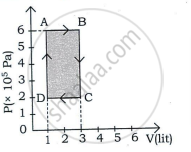Advertisements
Advertisements
Question
Can the given heat energy be completely converted to work in a cyclic process? If not, when can the heat can completely converted to work?
Solution
According to the first law of thermodynamics, work can be completely converted into heat. Since the system comes back to the initial stage, the change in the internal energy is zero. In the cyclic process, heat can flow into the system and heat flows out of the system. The net heat transferred to the system is equal to the work done by the gas.
Qnet = Qin = Qout = W (for 3 Cyclic Process)
APPEARS IN
RELATED QUESTIONS
Answer in brief.
Why should a Carnot cycle have two isothermal two adiabatic processes?
3 mole of a gas at temperature 400 K expands isothermally from an initial volume of 4 litres to a final volume of 8 litres. Find the work done by the gas. (R = 8.31 J mol-1 K-1)
Explain graphically (i) positive work with varying pressure, (ii) negative work with varying pressure, and (iii) positive work at constant pressure.
Explain the thermodynamics of the isobaric process.
Explain thermodynamics of the adiabatic process.
Draw the PV diagram for the isochoric process.
Explain in detail the isothermal process.
A monoatomic gas of pressure p having volume V expands isothermally to a volume 2V and then adiabatically to a volume 16V. The final pressure of the gas is ____________.
`("ratio of specific heats" = 5/3)`
The work done on the system in changing the state of a gas adiabatically from equilibrium state A to equilibrium state B is 22.4 J. If the gas is taken from state A to B through another process in which the net heat absorbed by the system is 15.5 cal, then the net work done by the system in the latter case is ______.
( l cal = 4.2 J)
An ideal gas is taken through a cyclic process ABCDA as shown in figure. The net work done by the gas during the cycle is ______.

